aktif öğrenme yöntemleri ile 20. yüzyıl sanat akımları
The topic which is preferred as being among the 20th century art movements, is within the curriculum of visual arts lesson and the art movements which were taught to the students are within the program of 11th and 12th graders. Apart from these, some other art movements were included because they were considered as necessary. The art movements are introduced in detail in the study however, during the instructions the main points of them were presented to the learners with visuals so that they can keep them in their long term memories. With the constructivist approach, the perspective has shifted to an active learning perspective and many aspects of this approach has been investigated in numerous studies. However, for most of the time those studies depend on quantitative data and experimental results and the construction of the processes of lessons have not been covered sufficiently. In the present study it is aimed to investigate the teaching of 20th century art movements to 16-17 year old secondary school students with the method of active learning. Within the framework of the study, the 20th century art movements were taught with active learning method and afterwards the learners were asked to produce art crafts with the information they received. It was aimed to observe the changes after the instruction and moreover it was aimed to recognize the difficulties in application of the curriculum of Ministry of Education and bring forward proposals for solution. In order to examine the efficiency of the method more closely and in its natural circumstance, action research methodology was adopted and the following research questions were aimed to be answered; 1. What sorts of effects does teaching 20th century art movements by implementing active learning methods have on students’ academic achievement and their knowledge acquisition and using skills? 2. How does teaching 20th century art movements by implementing active learning methods affect students in terms of their questioning and analyzing work of art? 3. Is teaching of the 20th century art movements with the active learning method effective in fostering the use of different techniques while creating their own designs? 4. Has teaching of the 20th century art movements with the active learning method provided the students with the opportunity of directing the application process in a positive way? 5. How does teaching 20th century art movements by implementing active learning methods affect students in terms of their developing sense of belonging though their studies and comparing these studies with their previous ones? 6. Is the topic of 20th century art movements in the curriculum of visual art teaching addressing the needs of our time and curriculum of visual arts lesson sufficient? In the present study, first of all the literature review was conducted on the description, necessity and aims of the art education, and its place was described at individual and social levels. After that the definitions of the 20th century art movements, their necessity are presented and finally the importance, methodologies and underpinnings of active learning theory is discussed. The study was conducted with 8 participants who are students at Kocaeli Çayırova Şehit İlhan Küçüksolak Anatolian High School in 2016-2017 academic year. The participants were selected with purposeful sampling method. The application which was conducted for 5 weeks period is supported with theoretical presentations and practices. In the study, observation checklists, semi-structured interview protocols, personal information forms, written/visual documents, researcher/participant diaries, photos and voice recordings were used as data gathering tools. The results of the study indicates that the students have learned the 20th century art movements which were instructed with active learning effectively and permanently. The results also indicate that at the end of this process, the students became able to include different techniques and materials in their works. The have also become individuals who are able to conduct their own works more consciously, uniquely and independently. Keywords: Art Education, Visual Arts Lesson, 20th Century Art Movements, Active Learning,Anahtar Sözcük; Sanat Eğitimi, Görsel sanatlar dersi, 20. Yüzyıl Sanat Akımları, Aktif Öğrenme,
___
- Açıkgöz, K. Ü. (2003), Aktif Öğrenme (2. Baskı). İzmir: Eğitim Dünyası Yayınları.
- Ada, S., Baysal, Z.N. (2013). Pedegojik-Androgojik Formasyon Ve Türkiye’de Öğretmen Yetiştirme. Anakara: Pegem Yayıncılık.
Artut, K. (2009). Sanat Eğitimi, Kuramları Ve Yöntemleri (6.Baskı). Ankara: Anı Yayıncılık.
- Balcı, A. (2015). Sosyal Bilimlerde Araştırma Yöntem Teknik ve İlkeler. Ankara: Pegem Yayıncılık.
- Bulut, Ü. (2001). Resim Öğretmenliği Lisans Programında Alan Bilgisi Derslerinin İşlevselliği. X. Ulusal Eğitim Bilimleri
Kongresi (s.476). Bolu: Abant İzzet Baysal Üniversitesi.
- Buyurgan, S., Buyurgan, U. (2012) Sanat Eğitimi Ve Öğretimi, (3. Baskı). Ankara: Pegem Yayıncılık.
- Büyüköztürk, Ş., Çakmak, E. vd. (2013).Bilimsel Araştırma Yöntemleri (14. Baskı). Ankara: Pegem Yayıncılık.
- Erinç, Sıtkı. (1995). Resmin Eleştirisi Üzerine. İstanbul: Hil Yayıncılık.
- Güneyli, A. (2007). Etkin Öğrenme Yaklaşımının Anadili Eğitiminde Okuma Ve Yazma Becerilerini Geliştirmeye Etkisi. Ankara Üniversitesi Sosyal Bilimler Enstitüsü Doktora Tezi: Ankara.
- M.E.B. (2009). Görsel Sanatlar Dersi Öğretim Programı(9-12.Sınıf). Ankara: Milli Eğitim Yayınevi.
- Özsoy, V. (2005). Resim (Sanat) Eğitiminde Özel Öğretim Yöntemleri. Ankara: Ders Notları.
- Sevindik, T.(2010) Özel Öğretim Yöntemleri. İstanbul: Yıldız Teknik Üniversitesi. http://www.yarbis1.yildiz.edu.tr/web/userannouncementsfiles/dosyab6b0482868ab2edc90f2394f4480ef51.pdf adresinden 19 Şubat 2017 tarihinde edinilmiştir.
- Slavın, R. E. (2013). Eğitim Psikolojisi. Çev. Galip Yüksel. Ankara: Nobel Yayıncılık.
- Şahiner, R. (2008). Sanatta Postmodern Kırılmalar ya da Modernin Yapı Bozumu. İstanbul: Yeni İnsan Yayıncılık.
- Taşdemir, V. N. (2001). Resim Öğretmenliği Lisans Programında Alan Bilgisi Derslerinin İşlevselliği. X. Ulusal Eğitim Bilimleri Kongresi(s.479). Bolu: Abant İzzet Baysal Üniversitesi.
- Yıldırım, A., Şimşek, H. (2011). Sosyal Bilimlerde Nitel Araştırma Yöntemleri (5. Baskı). Ankara: Seçkin Yayıncılık.
- Varış, F. (1998). Eğitim Bilimine Giriş: Eğitim ve Felsefe (4. Baskı). Ankara: Alkan Yayınları.
